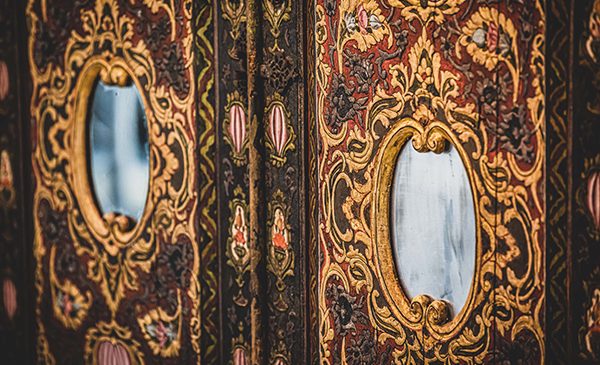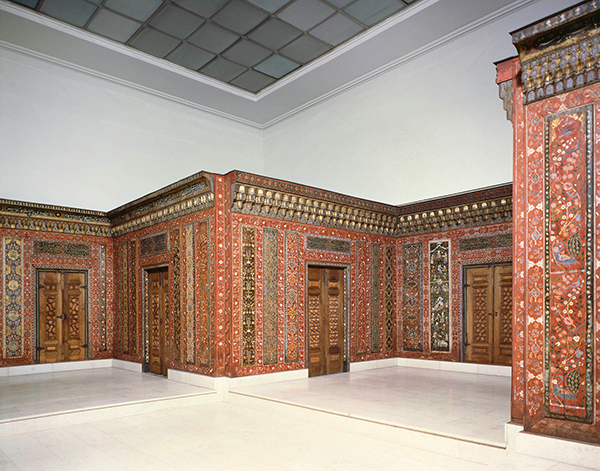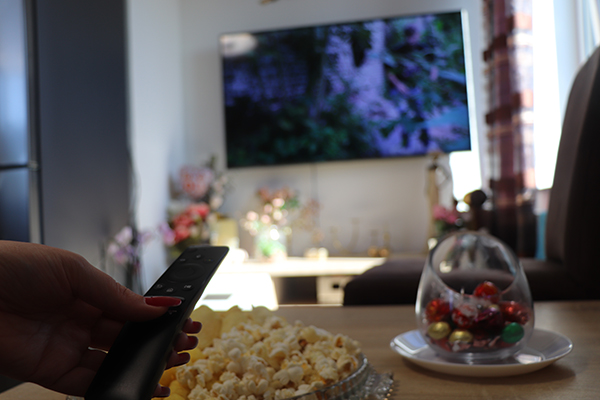By Abdul Baset Kannawi and Youssef Kanjou
The two members of the editorial team and Syrian archaeologists report here on two magnificent historical rooms in German museums. Both served as reception rooms for wealthy Syrian merchants in the cities of Damascus and Aleppo.
Since September 2022, the Damascus Room has been open to the public after 25 years of restoration work at the Museum für Völkerkunde in Dresden. It is not known exactly when this state room was created, but it is assumed to be around 1810, because this date is at the end of a famous poem by Imam Al-Ghazali, which was engraved on one of the walls of the room. It begins like this: “Necessity has destroyed hearts, my Lord, therefore bring relief with haste.”

The Damascus Room has had a chequered history. It was used for ninety years in Syria as a reception room in the old city of Damascus. In 1899, the German collector Karl Ernst Osthaus bought it and had it brought to Germany. When his interests turned to modern art and technology, the room was no longer exhibited but stored in Hagen (North Rhine-Westphalia). After the collector’s death, the room was donated to the Museum für Völkerkunde in Dresden in 1930. Until restoration work began in 1997, the room remained in the museum’s storerooms. Twenty-two restorers, also from Syria, were involved in the restoration.
The Damascus Room is considered a masterpiece of Syrian decorative art and is one of only a few that have been preserved as a complete room with all the basic decorative elements intact. The room is 4.5 metres long, 4 metres wide and 5.4 metres high. Two thirds of the wall height are covered with coloured wood panelling and inscriptions, for which mainly local poplar wood was used. Particularly noteworthy are two mashrabiyya, decorative wooden grilles of traditional Islamic architecture, which were used as lattice barriers in mosques, as window grilles or balcony panelling in residential houses and palaces. The decorations are rococo in style and contain countless details: bouquets of flowers, stylised cityscapes, bowls with a wide variety of fruits and traditional colourful geometric motifs in gold, red, orange-red and shiny metallic black. All this blends into an overall picture that should indicate the mastery of the artists and craftsmen and the luxury and wealth of the owner.
The Aleppo Room has been in Berlin since 1912 in what is now the Museum of Islamic Art, for which the art historian and collector Friedrich Sarre bought it in Syria. It was furnished around 1600 by the artist Halab Shah Bin Issa at the request of a wealthy Aleppo merchant named Issa Ibn Boutros. The Aleppo Room is typical of the architectural style of Arab houses of the time, which had to have a reception room for customers and guests that corresponded to the social status of the owner of the house. According to the museum, the wall design of the room is the oldest known of its kind, as it could only have been created in the trading city of Aleppo.
Paintings on wood adorn all the walls of this room. The colours were applied in several layers, a style that was common at the time. The artistic themes deal with a variety of cultural phenomena. Thus, there are about five hundred decorative elements with religious, social, literary and political themes. From a religious point of view, we mainly find scenes from the Christian faith, since the owner of the house was a Christian. For example, there are depictions of the Last Supper of Jesus, Mary with the infant Jesus or St. George. This is framed by Ottoman Islamic art, which is mainly based on plant and geometric motifs. It was also important to the artist to depict common phenomena of the Christian and Islamic faiths that are mentioned in the Koran and the New and Old Testaments, such as the sacrificial scene of Abraham and Isaac. In addition, there are also a number of inscriptions in Arabic on themes of lifestyle in Arab and Persian culture, such as “Man’s salvation lies in guarding his tongue” or “Complacency is an indication of weakness of spirit”. The Aleppo Room is an expression of the local culture, which in the city of Aleppo is characterised by friendly coexistence and tolerance between different religions, sects and ethnic groups with Christian, Jewish or Islamic, Arab or Persian backgrounds. This also characterises the social and economic communication between these groupings.
The war in Syria led to the destruction and theft of much of this type of art, which decorated traditional houses in Aleppo and Damascus. Fortunately, however, a number of such rooms still exist in museums in Syria (Aleppo and Damascus) and around the world, not only in Berlin and Dresden, but also, for example, in the Metropolitan Museum of Art in New York.
The Aleppo Room in Berlin and the Damascus Room in Dresden have attracted many Syrian refugees to German museums. This has also led to the formation of a feeling among the refugees that they are not alone here, but that part of their ancestors’ heritage has also come to Germany before them.
Both museums see the Syrian rooms and their anterooms not only as exhibition spaces, they should also be able to be used as places for people to meet, for events and as a “place of hospitality” and thus come close to their original purpose in Syria again.
More about the two Syrian rooms at:
Die Restaurierung des Dresdner Damaskuszimmers im Japanischen Palais – YouTube
Dresden: Wie das Damaskuszimmer aus dem Depot gerettet wurde | MDR.DE
The Aleppo Room: Magnificent murals – DW – 06/17/2019
Discover Islamic Art: The Aleppo Room Museum of Islamic Art at State Museums Berlin – YouTube
tun23011106
www.tuenews.de
Aleppo-Zimmer im Museum für Islamische Kunst, Berlin. Foto: Staatliche Museen zu Berlin, Museum für Islamische Kunst / Georg Niedermeiser.
001835
001836




